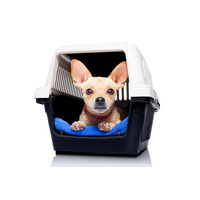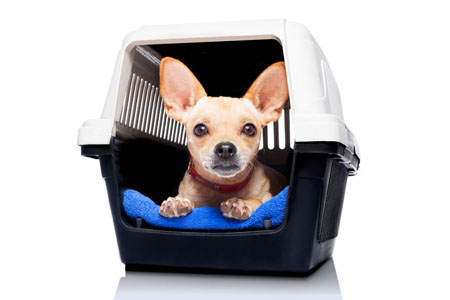Beginner's Guide to Crate Training for Dogs
Author: Vebo Pet Supplies Date Posted:18 January 2018

As we are seeing an ever increasing number of professional dog trainers promoting / requiring crate training as part of their overall training. We thought it would be a good idea to give people a crash course on this topic.

As we are seeing an ever increasing number of professional dog trainers promoting / requiring crate training as part of their overall training. We thought it would be a good idea to give people a crash course on this topic.
Before we begin, let's answer a few commonly asked question first:
What is crate training?
It may sound like a fancy term, but it's really just about getting your dog used to being inside a crate. As you can probably imagine, older dogs who have never been in a cage-like enclosure tend to freak out as soon as you put them inside. Whereas dogs that are crate trained will mostly see it as a bed or resting place, so they remain calm inside for a much longer period (of course if you lock up a dog in a crate long enough, they will also eventually freak out). Crate training doesn't really mean you need to lock up your dog all the time. In contrast, most crate trained dogs just use their crates like a bed, and the door probably is open most of the time
Is it cruel to put my dog in a crate?
If done incorrectly, yes it can be. But done correctly, it is not cruel at all. Dogs, like wolves, used to sleep in dens in the wild because it keeps them safe at night. Since they no longer live in the wild and have predators come after them, there isn't a real "need" to do it, so their preference is probably not as strong nowadays. However, it's certainly not harmful or against their nature to sleep in a den-like structure. In fact, they naturally feel safer in their "dens" and that is definitely a good thing for any dogs, especially fearful or nervous ones.
Our last dog was never crate trained and turned out fine. Why should I crate train my new dog?
Like we mentioned before, dogs do not NEED to sleep in dens now because they are not living in the wild. So it's not a must-have, it's just a nice-to-have skill. A dog can turn out perfectly fine without any crate training, just like a person can be a successful athele without learning how to swim. Considering most people are living in smaller homes, on smaller blocks and in more populated cities, it's really not a bad thing to learn to feel calm in small spaces. Travel by air? Your dog goes in a crate. Feeling sick? Vet is going to put your dog in a cage. Going to a holiday home or camping? It's super handy if your dog sleeps in a crate. The list goes on.
Crate training can also help a dog to learn to self sooth while being separated from its owner, so it will have a positive effect on dogs with separation anxiety and most nervous dogs in general. Separation anxiety could often lead to other behavioral issues like barking and digging, so it may also help to prevent/address those issues indirectly. It is also highly effective to toilet training a puppy using a crate, please refer to our toilet training guide for more details.
Crate Training Step-by-Step
(1) Introduce your dog to its crate
This step sometimes isn't necessary for young puppies, because they are raised inside a whelping box or some sort of enclosure, so they are not afraid of the crate. For older dogs who have never spent much time in a crate, you may find them reluctant to step inside the crate.
Obviously you will need a crate first. There are many different styles of crates out there, but we recommend using a metal crate like this for crate training because dogs like to scratch and chew. You can get a bigger crate with more room if you want, but if your dog is not toilet trained yet, you may want to limit the size of the crate so that if your dog pees in the crate, he will not have enough space to hide from it, so your dog learns to hold while in the crate.
You want the first impression to be a good one so the key here is to keep it positive.
Don't rush and force / lock your dog in a crate, leave the door open, put its favourtie treats or toys inside so the dog associate the crate with good things. Don't apply any pressure on the dog at this stage, if your dog is only willing to sneak in to grab the food and run straight back out, let it do exactly that until it's no longer afraid to go in.
Goal: Your dog lets its guard down and is willing to walk into the crate voluntarily
(2) Short term crating
Now your dog isn't afraid to enter the crate, you are ready to try closing the door.
The best way to do it is to feed your dog in its crate because (1) it continues to reinforce the positive image of crating (b) it helps to distract your dog so it's focusing more on the food and less on being locked in (3) it's something you need to do daily anyway so it saves time.
So put the food bowl inside the crate, wait for your dog to go in and starts eating, then close the door when your dog is eating. Stay there and watch your dog. When your dog finishes eating, try to make it wait a few minutes before letting it out. You can gradually make your dog wait longer each day, and try leaving the room to add the difficulty.
Tip: If your dog is starting to freak out, open the door and let your dog out right away because you want to keep things positive at this phase.
Goal: Your dog can stay calm and sit quietly inside the crate for up to 30min
(3) Sleeping in the crate
Sometimes people make a mistake at this point thinking their dog is ready, so they leave their dog in the crate for 2-3 hours while they go out. Being alone in a crate for 2-3 hours during the day (at night it's different) is no easy feat even for a well trained dog, so it can be upsetting for a newbie. Crying alone helplessly for hours is an awful experience, and those owners wonder why their dogs never warm up to the crate!
We recommend another step before longer period crating, which is to train your dog to sleep in the crate at night.
The reason is that your dog is less energetic at night and you are home with the dog. So if your dog gets upset at any point and starts barking, you are there to help so it won't escalate to a full meltdown. So the idea is to put your dog in the crate at night when everyone is ready to go to bed. Make sure you take it out for a wee last thing before you sleep, and first thing when you wake up. Also try your best to make it really comfortable in there with its favourite bed and toys. A water bowl may help if you don't want to get up in the middle of the night in case the dog gets thirsty. If your dog barks or cries, go check on it so it knows you are always there.
Tip: Some dogs can sleep in the crate without much fuss on their first night, some younger pups may give you a hard time. If your dog cannot settle in its crate at night, you can try setting up the crate in your room or right outside of your room, so it feels like it's not alone. Once you have some sucess there, then you can gradually move the crate out.
Goal: Your dog can sleep calmly inside its crate with the door closed
(4) Using the crate with the door opened
Once your dog has gotten used to sleeping in the crate, you can try to leave the door opened at night. If your dog is not sleeping inside the crate, you may need to keep closing the door for a few weeks longer. If you dog willingly goes in the crate and sleeps inside on its own, then your dog officially graduates from crate training as it is now seeing the crate as a safe heavan.
At this point you should be able to put your dogs in the crate for a few hours during the day without too much issues. Obviously, it's not nice to get locked up in your bedroom for half a day, so ideally it should be reserved for one-off situations. If you cannot afford to let your dog roam around when no one is home, you should consider one of the outdoor dog kennel runs.

 Collapsible
Collapsible